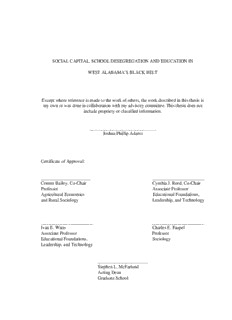
social capital, school desegregation and education in west alabama's black belt PDF
Preview social capital, school desegregation and education in west alabama's black belt
SOCIAL CAPITAL, SCHOOL DESEGREGATION AND EDUCATION IN WEST ALABAMA’S BLACK BELT Except where reference is made to the work of others, the work described in this thesis is my own or was done in collaboration with my advisory committee. This thesis does not include propriety or classified information. _____________________________ Joshua Phillip Adams Certificate of Approval: ______________________ _______________________ Conner Bailey, Co-Chair Cynthia J. Reed, Co-Chair Professor Associate Professor Agricultural Economics Educational Foundations, and Rural Sociology Leadership, and Technology _______________________ _______________________ Ivan E. Watts Charles E. Faupel Associate Professor Professor Educational Foundations, Sociology Leadership, and Technology ______________________ Stephen L. McFarland Acting Dean Graduate School SOCIAL CAPITAL, SCHOOL DESEGREGATION AND EDUCATION IN WEST ALABAMA’S BLACK BELT Joshua Phillip Adams A Thesis Submitted to the Graduate Faculty of Auburn University in Partial Fulfillment of the Requirements for the Degree of Master of Science Auburn, Alabama December 16, 2005 SOCIAL CAPITAL, SCHOOL DESEGREGATION AND EDUCATION IN WEST ALABAMA’S BLACK BELT Joshua Phillip Adams Permission is granted to Auburn University to make copies of this thesis at its discretion, upon request of individuals or institutions and at their expense. The author reserves all publication rights. ______________________ Signature of Author ______________________ Date of Graduation iii VITA Joshua Phillip Adams, son of Phil and Chris Adams, was born on October 13, 1978, in Opelika, Alabama. After graduating from Lee-Scott Academy in Auburn, Alabama in 1997, he entered The University of Mississippi in Oxford. Josh graduated with a Bachelor of Arts in Sociology in May 2002. After studying foreign language in Granada, Spain and living in Austin, Texas for one year, he returned to Auburn University for graduate school in August 2002. iv THESIS ABSTRACT SOCIAL CAPITAL, SCHOOL DESEGREGATION AND EDUCATION IN WEST ALABAMA’S BLACK BELT Joshua Phillip Adams Master of Science, December 16, 2005 (B.A. University of Mississippi, 2002) 151 Typed Pages Directed by Conner Bailey and Cynthia J. Reed The 12 counties constituting Alabama’s Black Belt region are characterized, generally, by persistent poverty, poorly funded education systems, and racial stratification. Fifty-one years after Brown v. Board of Education, education in Alabama’s Black Belt counties continues to be highly segregated between white private academies and public school systems where African American parents send their children. I examine the educational structures, experiences and racial interactions in three contiguous Black Belt counties using a case study approach. Through the conceptual framework of social capital, I explore the historical and persistent phenomenon of school segregation and the relationship between public and private schools. Findings indicate the legacy of school desegregation and the maintenance of “dual school systems” in west Alabama’s Black v Belt may be eroding in communities but continues nonetheless to adversely affect educational opportunity resulting in community disconnection along racial line. vi Style manual or journal used: Rural Sociology _________________________________________________________ Computer software used: Microsoft Word and Excel 2004 for Mac _________________________________________________________ vii TABLE OF CONTENTS LIST OF FIGURES………………………………………………………………….…...x I. INTRODUCTION………………………………………………………………….…..1 Research Objective Education and Rural Development in the Black Belt The Shift Towards Community Development The Black Belt Alabama’s Black Belt Why Alabama’s Black Belt II. CONCEPTUAL FRAMEWORK………………………………………………….…14 Social Capital and Education Social Capital and Negative Outcomes Bonding, Bridging and Linking Social Capital for Community Development III. METHODOLOGY………………………………………………………………......30 Conducting School Desegregation Research Selection of Counties/School District in Study A Unique Situation: Gaining Access and the Interview Process Measuring Social Capital A Researcher’s Brief Reflections IV. SCHOOL DESEGREGATION COMES TO THE BLACK BELT….......................44 Brown v. Board and a Legacy of Defiance The Critical Years (1963-1970) Understanding Dual School Systems Private Education and the Segregation Academies of Alabama’s Black Belt Public Education in the Black Belt Synthesizing Social Capital and School Desegregation School Desegregation and Alabama in the 21st Century The Critical Period of the 21st Century V. CASE STUDY: SUMTER COUNTY, ALABAMA………………………..…….....69 Sumter Academy Sumter County Public Schools The Educational Structure and Interaction of Sumter County viii VI. CASE STUDY: HALE COUNTY, ALABAMA…………………………….……..87 Southern Academy Hale County Public Schools The Educational Structure and Interaction of Hale County VII. CASE STUDY: MARENGO COUNTY, ALABAMA…………………………...104 Demopolis City Schools Marengo County Private Schools The Educational Structure and Interaction of Marengo County VIII. DISCUSSION………………………………………………………………...….118 The Black Belt Segregation and Education in the 21st Century – So What? So How Does Social Capital Fit Into All This? IX. CONCLUSION…………………………………………………………………….127 REFERENCES…………………………………………………………………………129 APPENDIX....……………………………………………………………………….....138 Figures Cited in Text ix LIST OF FIGURES Figure 1. Map of Sumter County, Alabama…………………………………………...139 Figure 2. Map of Hale County, Alabama……………………………………………...140 Figure 3. Map of Marengo County, Alabama…………………………………………141 x
Description: